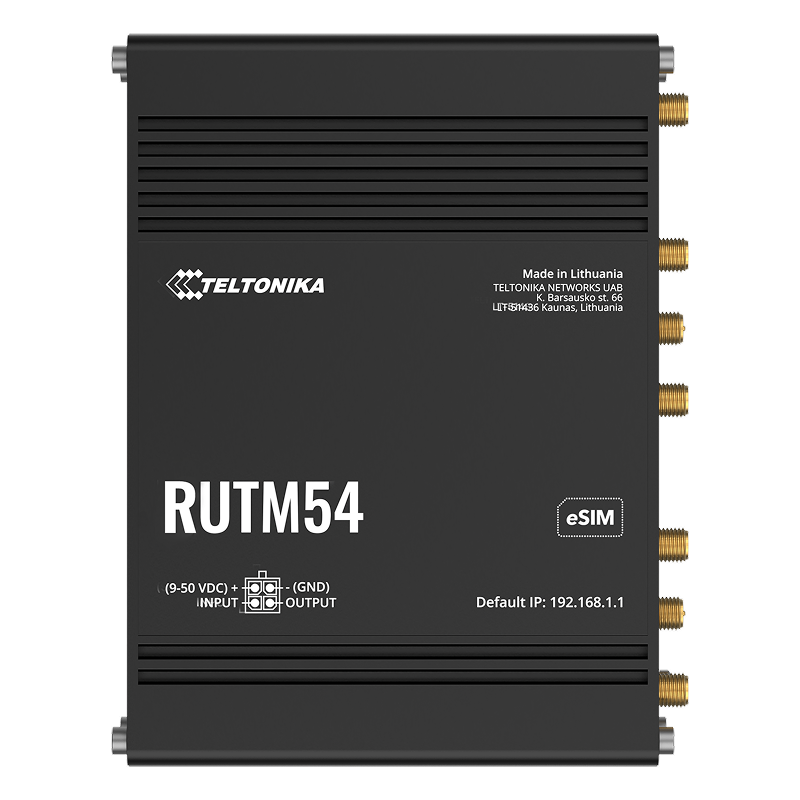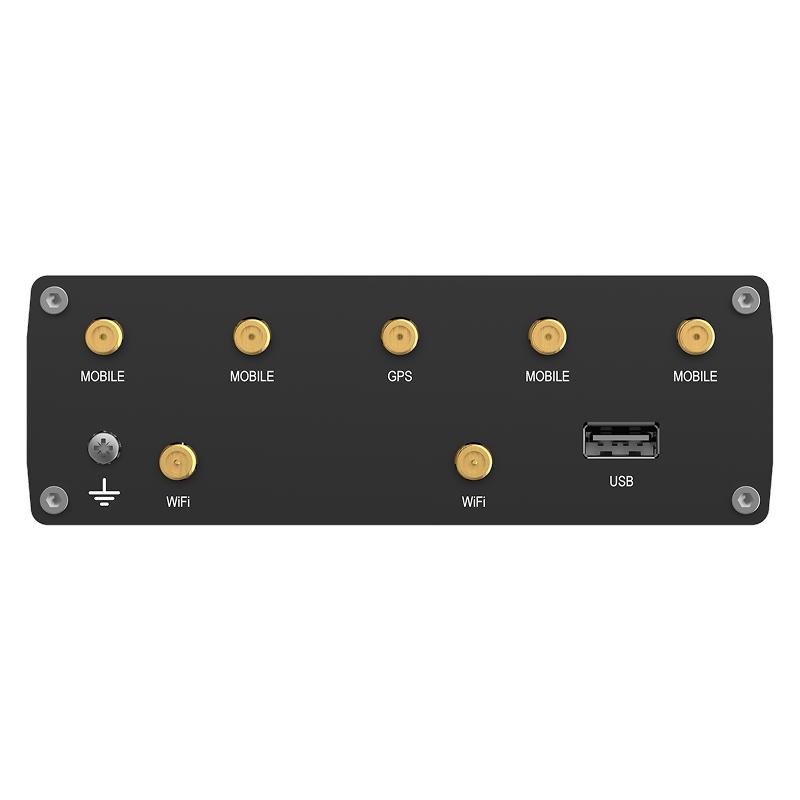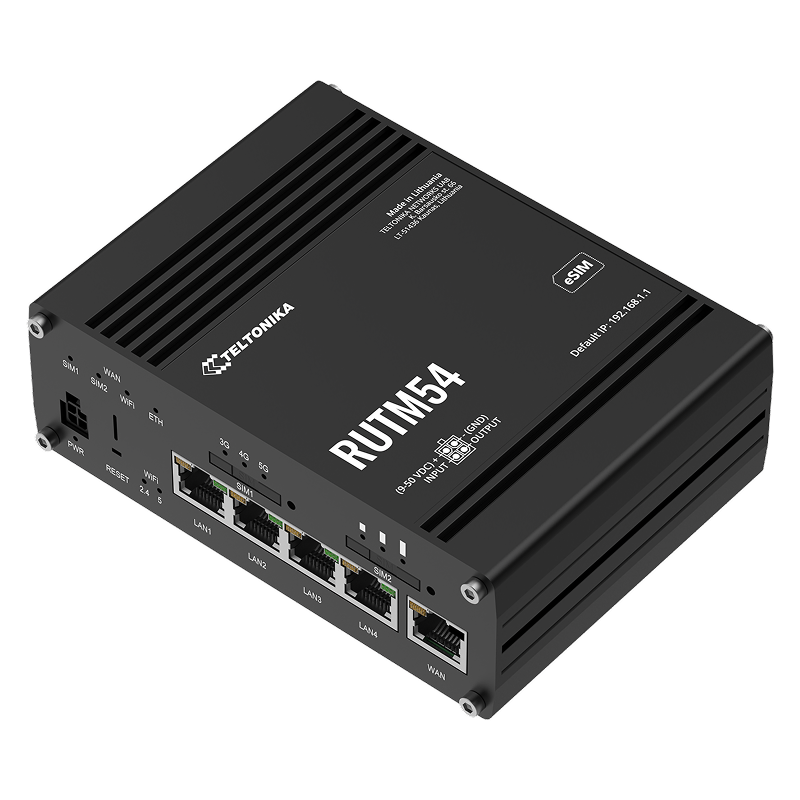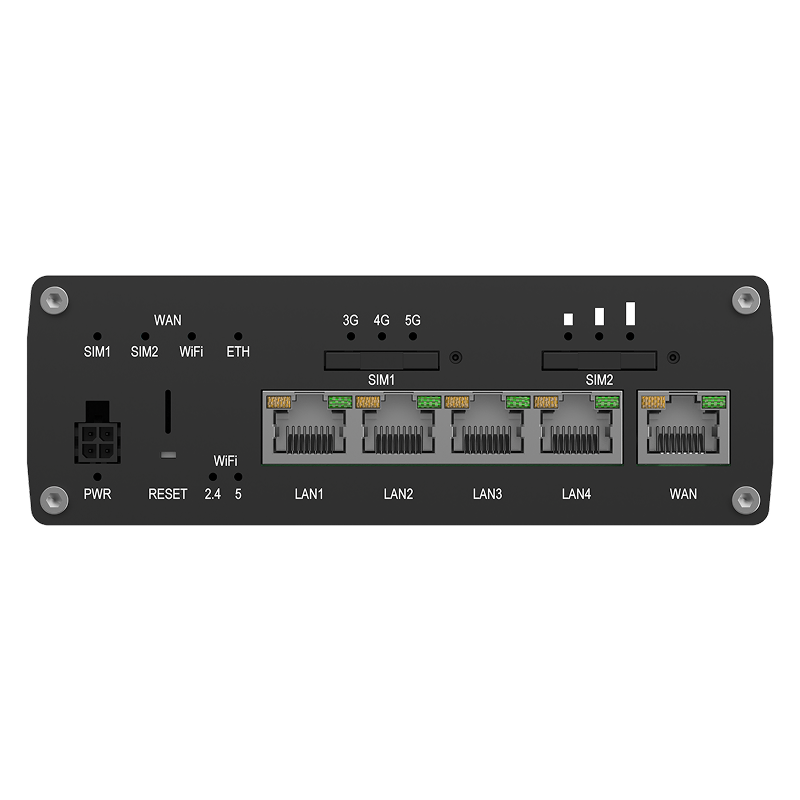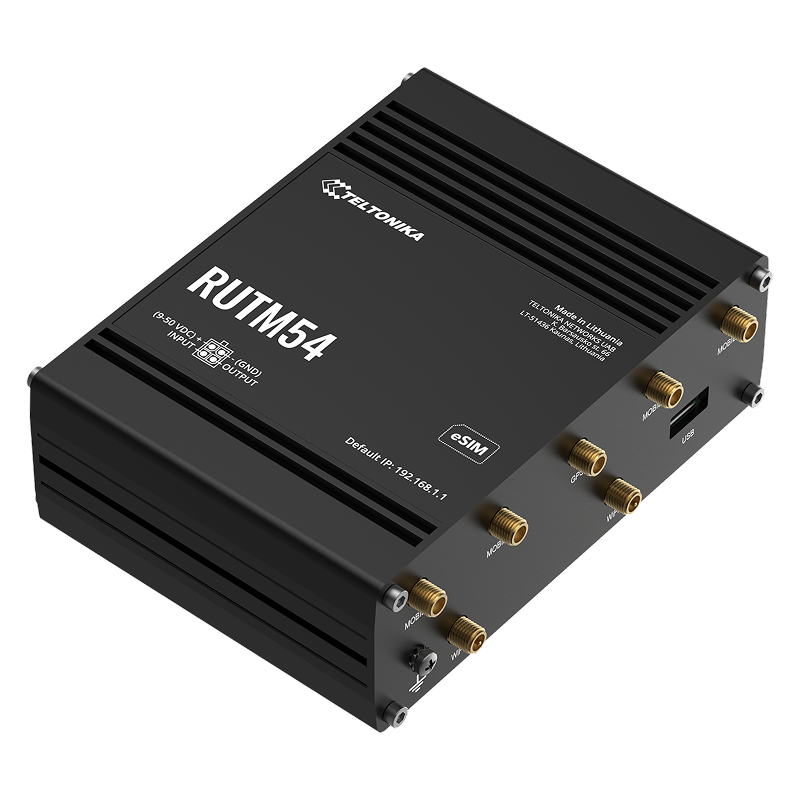




Tekniska specifikationer
Mobile
Cellular Module: 5G Sub-6GHz SA/NSA 2.5/3.4 Gbps download (4x4 MIMO), 900/550 Mbps upload (2x2); 4G (LTE) – LTE Cat 19 1.6 Gbps download, LTE Cat 18 211 Mbps upload; 3G – 42 Mbps download, 5.7 Mbps upload
3GPP Release: Release 16
eSIM: Consumer-grade eSIM, profile download and deletion capabilities, up to 7 eSIM profiles; does not include data plans
SIM switch: 2 SIM cards, automatic switching when: weak signal, data limit, SMS limit, roaming, no network, network denied, data connection error, SIM at rest protection
Status: IMSI, ICCID, operator, operator state, data connection status, network type, CA indicator, bandwidth, connected band, signal strength (RSSI), SINR, RSRP, RSRQ, EC/IO, RSCP, data sent/received, LAC, TAC, cell ID, ARFCN, UARFCN, EARFCN, MCC and MNC
SMS: SMS status, SMS configuration, EMAIL to SMS, SMS to EMAIL, SMS to HTTP, SMS to SMS, scheduled SMS, SMS auto-reply, SMPP
USSD: Support for sending and reading Unstructured Supplementary Service Data messages
Block/Allow List: Operator block/allow list (per country or individual operators)
Multiple PDNs: Ability to use different PDNs for multiple network accesses and services
Tape management: Tape lock, display of status of used tapes
SIM idle protection service: Provides the ability to configure the router to periodically switch to the unused SIM card and establish a data connection to prevent the SIM card from being blocked
SIM PIN code management: Ability to set, change or disable the SIM card PIN code
APN: Automatic APN
Bridge: Direct connection (bridge) between mobile operator and device on LAN
Passthrough: The router assigns its mobile WAN IP address to another device on the LAN
Framed routing: Support for an IP network behind 5G UE
3GPP Release: Release 16
eSIM: Consumer-grade eSIM, profile download and deletion capabilities, up to 7 eSIM profiles; does not include data plans
SIM switch: 2 SIM cards, automatic switching when: weak signal, data limit, SMS limit, roaming, no network, network denied, data connection error, SIM at rest protection
Status: IMSI, ICCID, operator, operator state, data connection status, network type, CA indicator, bandwidth, connected band, signal strength (RSSI), SINR, RSRP, RSRQ, EC/IO, RSCP, data sent/received, LAC, TAC, cell ID, ARFCN, UARFCN, EARFCN, MCC and MNC
SMS: SMS status, SMS configuration, EMAIL to SMS, SMS to EMAIL, SMS to HTTP, SMS to SMS, scheduled SMS, SMS auto-reply, SMPP
USSD: Support for sending and reading Unstructured Supplementary Service Data messages
Block/Allow List: Operator block/allow list (per country or individual operators)
Multiple PDNs: Ability to use different PDNs for multiple network accesses and services
Tape management: Tape lock, display of status of used tapes
SIM idle protection service: Provides the ability to configure the router to periodically switch to the unused SIM card and establish a data connection to prevent the SIM card from being blocked
SIM PIN code management: Ability to set, change or disable the SIM card PIN code
APN: Automatic APN
Bridge: Direct connection (bridge) between mobile operator and device on LAN
Passthrough: The router assigns its mobile WAN IP address to another device on the LAN
Framed routing: Support for an IP network behind 5G UE
Wireless
Wireless mode: 802.11b/g/n/ac Wave 2 (Wi-Fi 5) with data transfer rates up to 867 Mbps (Dual Band, MU-MIMO), 802.11r fast handover, Access Point (AP), Station (STA)
WiFi Security: WPA2-Enterprise - PEAP, WPA2-PSK, WPA-EAP, WPA-PSK, WPA3-SAE, WPA3-EAP, OWE; AES-CCMP, TKIP, Auto-cipher modes, client separation, EAP-TLS with PKCS#12 certificate, disable auto-reconnect, 802.11w Protected Management Frames (PMF)
SSID/ESSID: ESSID hidden mode (stealth mode)
Wi-Fi users: Up to 150 simultaneous connections
Wireless connectivity features: Wireless mesh (802.11s), fast roaming (802.11r), Relayd, BSS transition management (802.11v), radio resource metering (802.11k)
Wireless MAC filter: Allow list, block list
Wireless QR code generator: When the code is scanned, the user is automatically connected to the network without having to enter login credentials
TravelMate: Forwards the Wi-Fi hotspot landing page to a subsequent connected device
WiFi Security: WPA2-Enterprise - PEAP, WPA2-PSK, WPA-EAP, WPA-PSK, WPA3-SAE, WPA3-EAP, OWE; AES-CCMP, TKIP, Auto-cipher modes, client separation, EAP-TLS with PKCS#12 certificate, disable auto-reconnect, 802.11w Protected Management Frames (PMF)
SSID/ESSID: ESSID hidden mode (stealth mode)
Wi-Fi users: Up to 150 simultaneous connections
Wireless connectivity features: Wireless mesh (802.11s), fast roaming (802.11r), Relayd, BSS transition management (802.11v), radio resource metering (802.11k)
Wireless MAC filter: Allow list, block list
Wireless QR code generator: When the code is scanned, the user is automatically connected to the network without having to enter login credentials
TravelMate: Forwards the Wi-Fi hotspot landing page to a subsequent connected device
Ethernet
WAN: 1 x WAN port 10/100/1000 Mbps, compatible with IEEE 802.3, IEEE 802.3u, 802.3az standards, supports auto MDI/MDIX crossover
LAN: 4 x LAN ports, 10/100/1000 Mbps, compatible with IEEE 802.3, IEEE 802.3u, 802.3az standards, supports auto MDI/MDIX crossover
LAN: 4 x LAN ports, 10/100/1000 Mbps, compatible with IEEE 802.3, IEEE 802.3u, 802.3az standards, supports auto MDI/MDIX crossover
Network
Routing: Static routing, dynamic routing (BGP, OSPF v2, RIP v1/v2, EIGRP, NHRP), policy-based routing
Network protocols: TCP, UDP, IPv4, IPv6, ICMP, NTP, DNS, HTTP, HTTPS, SFTP, FTP, SMTP, SSL/TLS, ARP, VRRP, PPP, PPPoE, UPNP, SSH, DHCP, Telnet, SMPP, SNMP, MQTT, Wake On Lan (WOL), VXLAN
VoIP passthrough support: H.323 and SIP-alg protocol NAT helper that enables correct routing of VoIP packets
Connection Monitoring: Ping Reboot, Wget Reboot, Periodic Reboot, LCP and ICMP for Link Inspection
Firewall: Port forwarding, traffic rules, custom rules, TTL target customization
Firewall Status Page: Shows all your firewall statistics, rules, and rule counters
Port Management: View device ports, enable and disable each one, turn auto-configuration on or off, change transfer speed, and more
Network topology: Visual representation of your network showing which devices are connected to each other
DHCP: Static and dynamic IP assignment, DHCP relay, DHCP server configuration, status, static leases: MAC with wildcards
QoS / Smart Queue Management (SQM): Priority queuing of traffic based on source/destination, service, protocol or port, WMM, 802.11e
DDNS: Support for >25 service providers, others can be configured manually
DNS over HTTPS: DNS over HTTPS proxy enables secure DNS lookup by routing DNS requests over HTTPS
Network Backup: Wi-Fi WAN, Cellular, VRRP, Wired options, each of which can be used as automatic Failover
Load Balancing: Balances internet traffic across multiple WAN connections
Hotspot: Captive portal (hotspot), internal/external Radius server, Radius MAC authentication, SMS authorization, SSO authentication, internal/external landing page, walled garden, user scripts, URL parameters, user groups, individual or group restrictions, user management, 9 pre-selected customizable themes and the ability to upload and download your own hotspot themes
SSHFS: Ability to mount remote file systems via SSH protocol
VRF Support: Initial support for Virtual Routing and Forwarding (VRF)
Traffic management: Real-time monitoring, wireless signal graphs, traffic consumption history
Network protocols: TCP, UDP, IPv4, IPv6, ICMP, NTP, DNS, HTTP, HTTPS, SFTP, FTP, SMTP, SSL/TLS, ARP, VRRP, PPP, PPPoE, UPNP, SSH, DHCP, Telnet, SMPP, SNMP, MQTT, Wake On Lan (WOL), VXLAN
VoIP passthrough support: H.323 and SIP-alg protocol NAT helper that enables correct routing of VoIP packets
Connection Monitoring: Ping Reboot, Wget Reboot, Periodic Reboot, LCP and ICMP for Link Inspection
Firewall: Port forwarding, traffic rules, custom rules, TTL target customization
Firewall Status Page: Shows all your firewall statistics, rules, and rule counters
Port Management: View device ports, enable and disable each one, turn auto-configuration on or off, change transfer speed, and more
Network topology: Visual representation of your network showing which devices are connected to each other
DHCP: Static and dynamic IP assignment, DHCP relay, DHCP server configuration, status, static leases: MAC with wildcards
QoS / Smart Queue Management (SQM): Priority queuing of traffic based on source/destination, service, protocol or port, WMM, 802.11e
DDNS: Support for >25 service providers, others can be configured manually
DNS over HTTPS: DNS over HTTPS proxy enables secure DNS lookup by routing DNS requests over HTTPS
Network Backup: Wi-Fi WAN, Cellular, VRRP, Wired options, each of which can be used as automatic Failover
Load Balancing: Balances internet traffic across multiple WAN connections
Hotspot: Captive portal (hotspot), internal/external Radius server, Radius MAC authentication, SMS authorization, SSO authentication, internal/external landing page, walled garden, user scripts, URL parameters, user groups, individual or group restrictions, user management, 9 pre-selected customizable themes and the ability to upload and download your own hotspot themes
SSHFS: Ability to mount remote file systems via SSH protocol
VRF Support: Initial support for Virtual Routing and Forwarding (VRF)
Traffic management: Real-time monitoring, wireless signal graphs, traffic consumption history
Security
Authentication: Pre-shared key, digital certificates, X.509 certificates, TACACS+, internal and external RADIUS user authentication, IP address and login attempt blocking, time-based login blocking, built-in random password generator
Firewall: Pre-configured firewall rules can be enabled via WebUI, unlimited firewall configuration via CLI, DMZ, NAT, NAT-T, NAT64
Attack prevention: DDOS protection (SYN flood protection, SSH attack protection, HTTP/HTTPS attack protection), port scan protection (SYN-FIN, SYN-RST, X-mas, NULL flag, FIN scan attacks)
VLAN: VLAN separation based on port and tag
Mobile quota control: Mobile data limit, customizable period, start time, warning limit, phone number
WEB filter: Blacklist to block unwanted websites, whitelist to allow only specific websites
Access Control: Flexible access control for SSH, web interface, CLI and Telnet
SSL certificate generation: Let's Encrypt and SCEP as certificate generation methods
802.1x: Port-based network access control client
Firewall: Pre-configured firewall rules can be enabled via WebUI, unlimited firewall configuration via CLI, DMZ, NAT, NAT-T, NAT64
Attack prevention: DDOS protection (SYN flood protection, SSH attack protection, HTTP/HTTPS attack protection), port scan protection (SYN-FIN, SYN-RST, X-mas, NULL flag, FIN scan attacks)
VLAN: VLAN separation based on port and tag
Mobile quota control: Mobile data limit, customizable period, start time, warning limit, phone number
WEB filter: Blacklist to block unwanted websites, whitelist to allow only specific websites
Access Control: Flexible access control for SSH, web interface, CLI and Telnet
SSL certificate generation: Let's Encrypt and SCEP as certificate generation methods
802.1x: Port-based network access control client
VPN
OpenVPN: Multiple clients and one server can run simultaneously, 27 encryption methods
OpenVPN encryption: DES-CBC 64, RC2-CBC 128, DES-EDE-CBC 128, DES-EDE3-CBC 192, DESX-CBC 192, BF-CBC 128, RC2-40-CBC 40, CAST5-CBC 128, RC2-64-CBC 64, AES-128-CBC 128, AES-128-CFB 128, AES-128-CFB1 128, AES-128-CFB8 128, AES-128-OFB 128, AES-128-GCM 128, AES-192-CFB 192, AES-192-CFB1 192, AES-192-CFB8 192, AES-192-OFB 192, AES-192-CBC 192, AES-192-GCM 192, AES-256-GCM 256, AES-256-CFB 256, AES-256-CFB1 256, AES-256-CFB8 256, AES-256-OFB 256, AES-256-CBC 256
IPsec: XFRM, IKEv1, IKEv2, with 14 IPsec encryption methods (3DES, DES, AES128, AES192, AES256, AES128GCM8, AES192GCM8, AES256GCM8, AES128GCM12, AES192GCM12, AES256GCM12, AES128GCM16, AES192GCM16, AES256GCM16)
GRE: GRE tunnel, support for GRE tunnel over IPsec
PPTP, L2TP: Client and server instances can run simultaneously, support for L2TPv3 and L2TP over IPsec
Stunnel: Proxy designed to add TLS encryption to existing clients and servers without changing the application's code
DMVPN: Method for building scalable IPsec VPNs, supporting Phases 2 and 3 and Dual Hub
SSTP: SSTP client instance support
ZeroTier: ZeroTier VPN client support
WireGuard: Support for WireGuard VPN client and server
Tinc: Tinc offers encryption, authentication, and compression in its tunnels. Client and server support.
Tailscale: Tailscale offers speed, stability, and simplicity over traditional VPNs. Encrypted point-to-point connections using the open WireGuard protocol
OpenVPN encryption: DES-CBC 64, RC2-CBC 128, DES-EDE-CBC 128, DES-EDE3-CBC 192, DESX-CBC 192, BF-CBC 128, RC2-40-CBC 40, CAST5-CBC 128, RC2-64-CBC 64, AES-128-CBC 128, AES-128-CFB 128, AES-128-CFB1 128, AES-128-CFB8 128, AES-128-OFB 128, AES-128-GCM 128, AES-192-CFB 192, AES-192-CFB1 192, AES-192-CFB8 192, AES-192-OFB 192, AES-192-CBC 192, AES-192-GCM 192, AES-256-GCM 256, AES-256-CFB 256, AES-256-CFB1 256, AES-256-CFB8 256, AES-256-OFB 256, AES-256-CBC 256
IPsec: XFRM, IKEv1, IKEv2, with 14 IPsec encryption methods (3DES, DES, AES128, AES192, AES256, AES128GCM8, AES192GCM8, AES256GCM8, AES128GCM12, AES192GCM12, AES256GCM12, AES128GCM16, AES192GCM16, AES256GCM16)
GRE: GRE tunnel, support for GRE tunnel over IPsec
PPTP, L2TP: Client and server instances can run simultaneously, support for L2TPv3 and L2TP over IPsec
Stunnel: Proxy designed to add TLS encryption to existing clients and servers without changing the application's code
DMVPN: Method for building scalable IPsec VPNs, supporting Phases 2 and 3 and Dual Hub
SSTP: SSTP client instance support
ZeroTier: ZeroTier VPN client support
WireGuard: Support for WireGuard VPN client and server
Tinc: Tinc offers encryption, authentication, and compression in its tunnels. Client and server support.
Tailscale: Tailscale offers speed, stability, and simplicity over traditional VPNs. Encrypted point-to-point connections using the open WireGuard protocol
OPC UA
Supported modes: Client, Server
Supported connection types: TCP
Supported connection types: TCP
MODBUS
Supported modes: Server, Client
Supported connection types: TCP, USB
Custom registers: MODBUS TCP custom register block requests, which read/write to a file inside the router and can be used to extend the functionality of the MODBUS TCP client
Supported data formats: 8-bit: INT, UINT
16-bit: INT, UINT (MSB or LSB first)
32-bit: float, INT, UINT (ABCD (big-endian), DCBA (little-endian), CDAB, BADC), HEX, ASCII
Supported connection types: TCP, USB
Custom registers: MODBUS TCP custom register block requests, which read/write to a file inside the router and can be used to extend the functionality of the MODBUS TCP client
Supported data formats: 8-bit: INT, UINT
16-bit: INT, UINT (MSB or LSB first)
32-bit: float, INT, UINT (ABCD (big-endian), DCBA (little-endian), CDAB, BADC), HEX, ASCII
Data to server
Protocol: HTTP(S), MQTT, Azure MQTT
Data to Server: Extract parameters from multiple sources and different protocols and send them all to a single server; custom LUA scripting allows scripts to use the router's Data to Server feature
Data to Server: Extract parameters from multiple sources and different protocols and send them all to a single server; custom LUA scripting allows scripts to use the router's Data to Server feature
MQTT Gateway
Modbus MQTT Gateway: Allows you to send commands and receive data from a MODBUS server via an MQTT broker.
DNP3
Supported modes: DNP3 Station, DNP3 Outstation
Supported connections: TCP, USB
Supported connections: TCP, USB
DLMS/COSEM
DLMS support: DLMS is a standard for exchanging meter data from electricity and other utility meters.
Supported modes: Client
Supported connection types: TCP
COSEM: Enables scanning of COSEM objects in meters for automatic discovery and configuration.
Supported modes: Client
Supported connection types: TCP
COSEM: Enables scanning of COSEM objects in meters for automatic discovery and configuration.
API
Teltonika Networks Web API (beta) support: Extend the capabilities of your device with configurable API endpoints to retrieve or modify data. More info here: https://developers.teltonika-networks.com
Monitoring & Management
WEB UI: HTTP/HTTPS, status, configuration, firmware update, CLI, troubleshooting, multiple log servers, firmware update notifications, event log, system log, kernel log, internet status
FOTA: Firmware update from server with automatic notification
SSH: SSH versions 1 and 2
SMS: SMS status and configuration
Calls: Restart, show status, turn on/off mobile data, turn on/off outputs, answer/hang up with timer, turn on/off Wi-Fi
Email: Receive emails with status alerts for various services
TR-069: Supports multiple ACS protocols such as OpenACS, EasyCwmp, LibreACS and more
MQTT: MQTT broker and MQTT publisher
SNMP: Support for SNMP version 1, 2 and 3, SNMP Trap, protection against brute force attacks
JSON-RPC: Manage APIs via HTTP/HTTPS
MODBUS: Status and control via MODBUS TCP
RMS: Teltonika Remote Management System (RMS)
FOTA: Firmware update from server with automatic notification
SSH: SSH versions 1 and 2
SMS: SMS status and configuration
Calls: Restart, show status, turn on/off mobile data, turn on/off outputs, answer/hang up with timer, turn on/off Wi-Fi
Email: Receive emails with status alerts for various services
TR-069: Supports multiple ACS protocols such as OpenACS, EasyCwmp, LibreACS and more
MQTT: MQTT broker and MQTT publisher
SNMP: Support for SNMP version 1, 2 and 3, SNMP Trap, protection against brute force attacks
JSON-RPC: Manage APIs via HTTP/HTTPS
MODBUS: Status and control via MODBUS TCP
RMS: Teltonika Remote Management System (RMS)
IoT platforms
ThingWorx: Monitors WAN type, WAN IP, mobile carrier, mobile signal strength, and network type.
Cumulocity - Cloud of Things: Monitors device model, revision, serial number, WAN type/IP, mobile cell ID, ICCID, IMEI, connection type, carrier, and signal strength. Supports reboot and firmware update.
Azure IoT Hub: Can be configured to send all parameters to the cloud via Data to Server. Supports direct methods to run RutOS API calls from IoT Hub. Also has plug-and-play with Device Provisioning Service for easy device registration.
AWS IoT Core: Tools for interacting with the AWS cloud platform. Supports "Jobs" to call device APIs via AWS job functionality.
Cumulocity - Cloud of Things: Monitors device model, revision, serial number, WAN type/IP, mobile cell ID, ICCID, IMEI, connection type, carrier, and signal strength. Supports reboot and firmware update.
Azure IoT Hub: Can be configured to send all parameters to the cloud via Data to Server. Supports direct methods to run RutOS API calls from IoT Hub. Also has plug-and-play with Device Provisioning Service for easy device registration.
AWS IoT Core: Tools for interacting with the AWS cloud platform. Supports "Jobs" to call device APIs via AWS job functionality.
System properties
CPU: MediaTek, dual-core, 880 MHz, MIPS1004Kc
RAM: 256MB DDR3
FLASH memory: 16 MB serial NOR flash, 256 MB serial NAND flash
RAM: 256MB DDR3
FLASH memory: 16 MB serial NOR flash, 256 MB serial NAND flash
Firmware / Configuration
WEB UI: Update firmware from file, check firmware on server, configuration profiles, backup configuration
FOTA: Firmware update over network
RMS: Update firmware/configuration for multiple devices at once
Keep settings: Update firmware without losing existing configuration
Factory Reset: A full factory reset restores all system settings, including IP address, PIN, and user data to the manufacturer's original configuration.
FOTA: Firmware update over network
RMS: Update firmware/configuration for multiple devices at once
Keep settings: Update firmware without losing existing configuration
Factory Reset: A full factory reset restores all system settings, including IP address, PIN, and user data to the manufacturer's original configuration.
Firmware customization
Operating system: RutOS (Linux-based OpenWrt OS)
Supported languages: Busybox shell, Lua, C, C++
Development tools: SDK package with build environment provided
GPL Customization: You can create your own custom, branded firmware and website by changing colors, logos, and other elements to suit your or your customers' needs
Package manager: Service for installing additional software on the device
Supported languages: Busybox shell, Lua, C, C++
Development tools: SDK package with build environment provided
GPL Customization: You can create your own custom, branded firmware and website by changing colors, logos, and other elements to suit your or your customers' needs
Package manager: Service for installing additional software on the device
Position tracking
GNSS: GPS, GLONASS, BeiDou, Galileo and QZSS
Coordinates: GNSS coordinates via WebUI, SMS, TAVL, RMS
NMEA: NMEA 0183
NTRIP: Networked Transport of RTCM via Internet Protocol (NTRIP) protocol
Server software: Supported server software: TAVL, RMS
Geofencing: Configurable multiple geofence zones
Coordinates: GNSS coordinates via WebUI, SMS, TAVL, RMS
NMEA: NMEA 0183
NTRIP: Networked Transport of RTCM via Internet Protocol (NTRIP) protocol
Server software: Supported server software: TAVL, RMS
Geofencing: Configurable multiple geofence zones
USB
Data speed: USB 2.0
Applications: Samba share, USB-to-serial
External devices: Ability to connect external hard drive, flash drive, printer, USB-serial adapter
Storage formats: FAT, FAT32, exFAT, NTFS (read only), ext2, ext3, ext4
Applications: Samba share, USB-to-serial
External devices: Ability to connect external hard drive, flash drive, printer, USB-serial adapter
Storage formats: FAT, FAT32, exFAT, NTFS (read only), ext2, ext3, ext4
In-/Utgångar
Ingång: 1 x digital ingång, 0 - 6 V detekteras som logisk låg, 8 - 30 V detekteras som logisk hög
Utgång: 1 x digital utgång, open collector, max 30 V, 300 mA
Händelser: E-post, RMS, SMS
I/O-juggler: Möjlighet att ställa in vissa I/O-villkor för att initiera händelser
Utgång: 1 x digital utgång, open collector, max 30 V, 300 mA
Händelser: E-post, RMS, SMS
I/O-juggler: Möjlighet att ställa in vissa I/O-villkor för att initiera händelser
Ström
Kontakt: 4-polig industrikontakt för DC-ström
Inspänning: 9 – 50 VDC, omvänd polaritetsskydd, överspänningsskydd >51 VDC 10 µs max
PoE (passiv): Möjlighet att driva via LAN1-porten, ej kompatibel med IEEE802.3af, 802.3at och 802.3bt standarder, Mode B, 9 - 50 VDC
Strömförbrukning: Viloläge: < 4 W, Max: < 14 W
Inspänning: 9 – 50 VDC, omvänd polaritetsskydd, överspänningsskydd >51 VDC 10 µs max
PoE (passiv): Möjlighet att driva via LAN1-porten, ej kompatibel med IEEE802.3af, 802.3at och 802.3bt standarder, Mode B, 9 - 50 VDC
Strömförbrukning: Viloläge: < 4 W, Max: < 14 W
Fysiska gränssnitt
Ethernet: 5 x RJ45-portar, 10/100/1000 Mbps
I/O: 1 x digital ingång, 1 x digital utgång på 4-polig strömkontakt
Status-LEDs: 4 x WAN-typ, 3 x mobilanslutningstyp, 3 x mobilanslutningsstyrka, 10 x Ethernetportstatus, 1 x ström, 2 x 2.4G och 5G Wi-Fi
SIM: 2 x SIM-kortplatser (Mini SIM – 2FF), 1.8 V/3 V
Ström: 1 x 4-polig strömkontakt
Antenn: 4 x SMA för mobil, 2 x RP-SMA för Wi-Fi, 1 x SMA för GNSS
USB: 1 x USB A-port för externa enheter
Återställ: Omstart / Användardefinierad återställning / Fabriksinställningar återställningsknapp
Övrigt: 1 x jordningsskruv
I/O: 1 x digital ingång, 1 x digital utgång på 4-polig strömkontakt
Status-LEDs: 4 x WAN-typ, 3 x mobilanslutningstyp, 3 x mobilanslutningsstyrka, 10 x Ethernetportstatus, 1 x ström, 2 x 2.4G och 5G Wi-Fi
SIM: 2 x SIM-kortplatser (Mini SIM – 2FF), 1.8 V/3 V
Ström: 1 x 4-polig strömkontakt
Antenn: 4 x SMA för mobil, 2 x RP-SMA för Wi-Fi, 1 x SMA för GNSS
USB: 1 x USB A-port för externa enheter
Återställ: Omstart / Användardefinierad återställning / Fabriksinställningar återställningsknapp
Övrigt: 1 x jordningsskruv
Fysisk specifikation
Hölje: Anodiserat aluminiumhölje och paneler
Dimensioner (B x H x D): 132 x 44,2 x 95 mm
Vikt: 530 g
Monteringsalternativ: DIN-skena, väggmontering, plan yta (alla kräver tillbehör)
Dimensioner (B x H x D): 132 x 44,2 x 95 mm
Vikt: 530 g
Monteringsalternativ: DIN-skena, väggmontering, plan yta (alla kräver tillbehör)
Driftmiljö
Temperatur:-40 °C till 75 °C
Fuktighet: 10% till 90% icke-kondenserande
Ingress Protection Rating: IP30
Fuktighet: 10% till 90% icke-kondenserande
Ingress Protection Rating: IP30
Regulations and approvals
Regulatory: CE, UKCA, CB, FCC, IC, PTCRB, WEEE, RoHS, REACH
Operator: AT&T, T-Mobile
Operator: AT&T, T-Mobile
EMC emissions and immunity
Standards: (CE/UKCA and FCC/ISED standards listed, including EN 55032, EN 55035, EN 61000 series, EN 301 489 series)
RF standards
Standards: (CE/UKCA and FCC/ISED RF standards listed, e.g. EN 300 328, EN 301 893, 47 CFR Part 15)
RF exposure
Standards: (CE/UKCA and FCC/ISED RF exposure standards listed)
Security
Standards: CE/UKCA: EN IEC 62368-1:2020 + A11:2020
CB: IEC 62368-1:2018
CB: IEC 62368-1:2018
Garanti
2 års fabriksgaranti

Lightning-fast 5G speed

Dual SIM and eSIM™ with smart monitoring

Flexible 5G architecture: SA & NSA
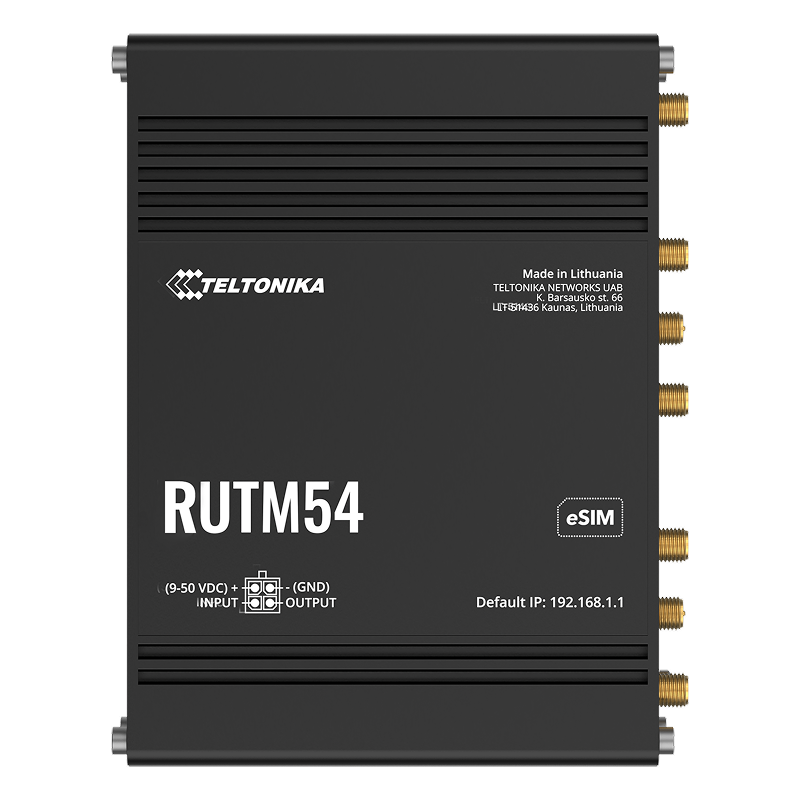
Reliable Telit modem
Do you want to know more about the product?
Contact us for a demo or if you have any questions.
